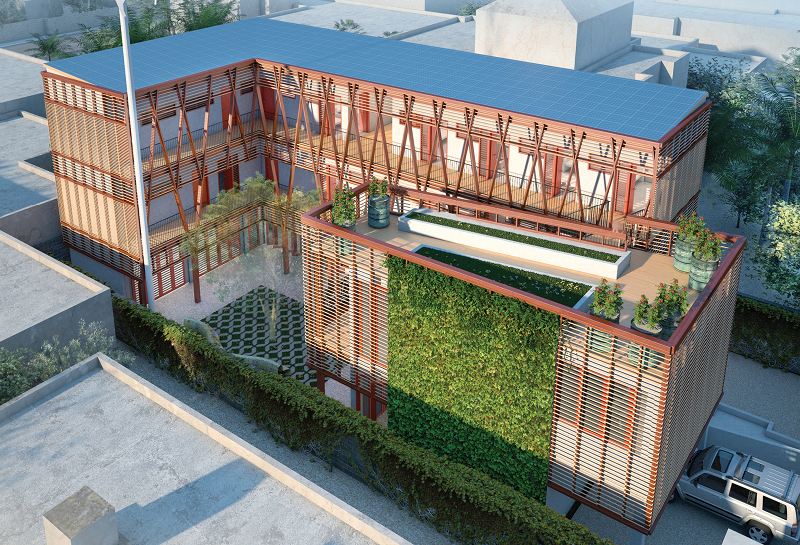In an era defined by unpredictable climate change, resource scarcity, and global uncertainties, the traditional approach to building design is no longer sufficient. It is no longer enough for a structure to be merely functional and aesthetically pleasing; it must also be resilient. Resilient building design is a proactive and holistic approach that ensures structures can withstand and quickly recover from a wide range of shocks and stresses, whether they are environmental, social, or economic. This concept moves beyond a simple focus on sustainability and durability to create buildings that can adapt, regenerate, and even thrive in the face of adversity. This comprehensive article will delve into the core principles, key strategies, and future outlook of resilient building design, exploring how it is shaping the future of architecture and urban planning to create safer, more secure, and more enduring communities.
Core Principles of Resilient Design

Resilience in architecture is built upon a foundation of interconnected principles that address a building’s entire lifecycle and its relationship with the surrounding environment and community. It is a multi-layered strategy that prepares a structure for the unexpected.
A. Robustness: This is the most fundamental principle. It refers to a building’s ability to resist external forces and maintain its structural integrity. A robust design ensures a building can withstand shocks such as earthquakes, floods, high winds, and fire without catastrophic failure. This involves using strong, durable materials and a structural system designed for worst-case scenarios.
B. Redundancy: Redundancy involves having backup systems or alternative pathways for critical functions. For example, a resilient building might have multiple power sources (e.g., solar panels, a generator) in case the main grid fails. This ensures essential services like lighting, communication, and HVAC can continue to operate during an emergency.
C. Resourcefulness: A resourceful building is one that can quickly and efficiently access and utilize resources during a crisis. This can be achieved by having on-site water storage, rainwater harvesting systems, or community-shared resources. The focus is on self-sufficiency and reducing dependence on external infrastructure that may be compromised.
D. Rapidity: This principle refers to the speed at which a building and its occupants can recover from a disruption. A resilient design facilitates a quick return to normalcy by using materials and systems that are easy to repair or replace. A building’s ability to “bounce back” is a critical measure of its resilience.
E. Adaptability: Adaptability is the capacity of a building to evolve and change over time in response to long-term stresses like climate change or shifts in community needs. An adaptable design might include flexible floor plans, modular components, and systems that can be easily upgraded to accommodate new technologies or functions.
Key Strategies for Resilient Building Design
Translating these principles into practice requires a range of specific, innovative strategies that are integrated from the initial planning stages. These strategies address both the physical structure and the operational systems of a building.
A. Climate-Informed Design: This involves designing a building specifically for the anticipated effects of climate change in its location. For coastal areas, this may mean elevating structures to protect against sea-level rise and storm surges. In regions prone to extreme heat, it involves using passive cooling strategies like deep overhangs, light-colored roofs, and highly insulated walls to reduce energy demand for air conditioning.
B. Multi-Hazard Protection: A truly resilient building is designed to withstand a range of threats, not just one. This includes using materials that are both fire-retardant and flood-resistant, and structural systems that can absorb seismic energy. For instance, a building could be designed with a water-resistant lower level and a fire-resistant exterior.
C. On-Site Resource Management: Reducing a building’s reliance on external utilities is a cornerstone of resilience.
- Integrated Water Systems: This includes rainwater harvesting for non-potable uses like irrigation and toilet flushing, and greywater recycling systems. These systems provide a backup water source during a municipal water outage.
- Decentralized Energy Production: On-site power generation from renewable sources like solar panels or small wind turbines provides a measure of energy independence. This can be coupled with battery storage to ensure power is available 24/7, even when the grid is down.
D. Passive Survivability: This concept refers to a building’s ability to maintain a habitable environment for its occupants even without active power or water. This is achieved through excellent insulation, natural ventilation, and daylighting. A passively survivable building can maintain a safe internal temperature and air quality for an extended period, which is crucial during a prolonged power outage.
E. Durable and Sustainable Materials: The choice of materials is critical to a building’s resilience. Using durable materials like precast concrete or mass timber that can withstand environmental forces reduces the need for frequent repairs and replacements. Additionally, materials should be sourced locally and responsibly to reduce the building’s embodied carbon and support the local economy.
The Role of Smart Technology in Resilience

Technology is not just an add-on; it is an intrinsic component of modern resilient design. Smart systems and data analytics enable a building to be more aware, responsive, and prepared for a crisis.
A. Predictive Analytics: Smart sensors can monitor a building’s performance and environmental conditions in real-time. This data can be used to predict potential failures, such as a structural weakness during a windstorm or a mechanical failure in a heating system, allowing for proactive maintenance and mitigation.
B. Automated Response Systems: In the event of a shock, smart systems can automatically respond to minimize damage. For example, a system could detect a flood and automatically activate pumps and deploy temporary barriers. Similarly, a smart fire system could not only sound an alarm but also seal off affected areas to contain the fire and its smoke.
C. Integrated Communication: A resilient building has a robust communication system that can function even when traditional networks are down. This could include a local mesh network for internal communication and satellite-based systems for external communication with emergency services. This ensures that occupants and building managers can stay informed and coordinate a response.
Community and Social Resilience
A building does not exist in a vacuum. Its resilience is inextricably linked to the resilience of the community it serves. Resilient design extends beyond the physical structure to foster a sense of social cohesion and collective support.
A. Creating Hubs for Community Support: Resilient buildings can be designed to serve as community hubs during a crisis. A school or a community center could be equipped with a backup generator and on-site resources to act as a shelter or an emergency operations center.
B. Fostering Social Capital: The design of a building can encourage social interaction and build social capital, the networks of relationships among people. This is crucial for resilience, as communities with strong social ties are better able to coordinate and support each other during and after a crisis.
C. Integrating with Urban Planning: Resilient building design must be integrated with broader urban planning strategies. For example, a resilient building in a flood-prone area should be part of a larger network of green infrastructure, such as parks and rain gardens, that work together to manage stormwater and reduce the overall risk of flooding.
Conclusion
Resilient building design is a paradigm shift that recognizes the dynamic and uncertain nature of our world. It is a departure from the static, traditional model of construction to one that is proactive, adaptable, and deeply interconnected with its environment and community. The principles of robustness, redundancy, resourcefulness, rapidity, and adaptability are not just technical guidelines; they are a philosophical framework for creating a built environment that can not only withstand adversity but can also contribute to a more secure and sustainable future.
The long-term impact of this architectural approach is profound. On an individual level, it ensures the safety and well-being of occupants. On a community level, it builds a foundation for collective recovery and growth. And on a global level, it contributes to a more sustainable and equitable world. By integrating climate-informed design, smart technology, and a focus on community resilience, we are building structures that are not just strong but are also intelligent, self-sufficient, and socially responsible. The investment in resilient design is a commitment to a future where our buildings are not just shelters but are a source of strength, stability, and hope in an ever-changing world. It is a powerful reminder that our greatest creations are those that serve us not only in times of ease but also in times of greatest need.











